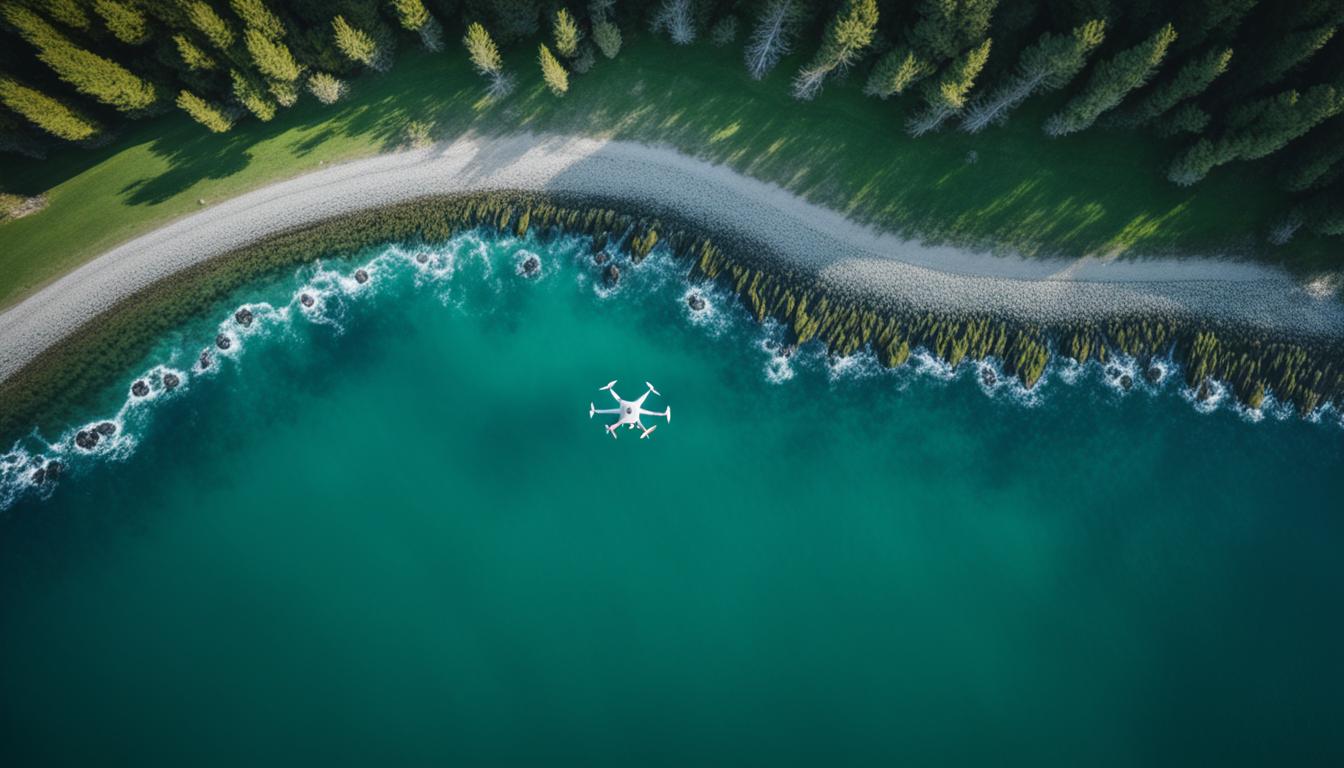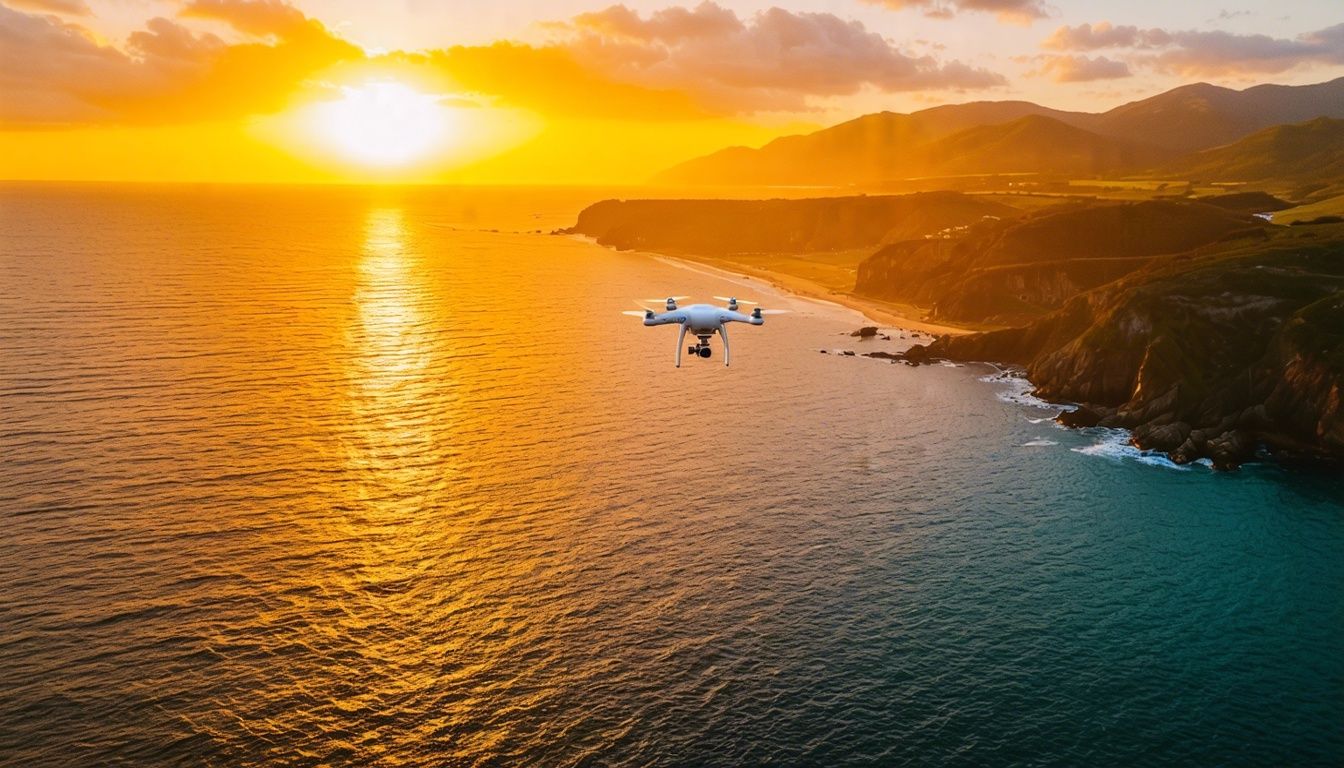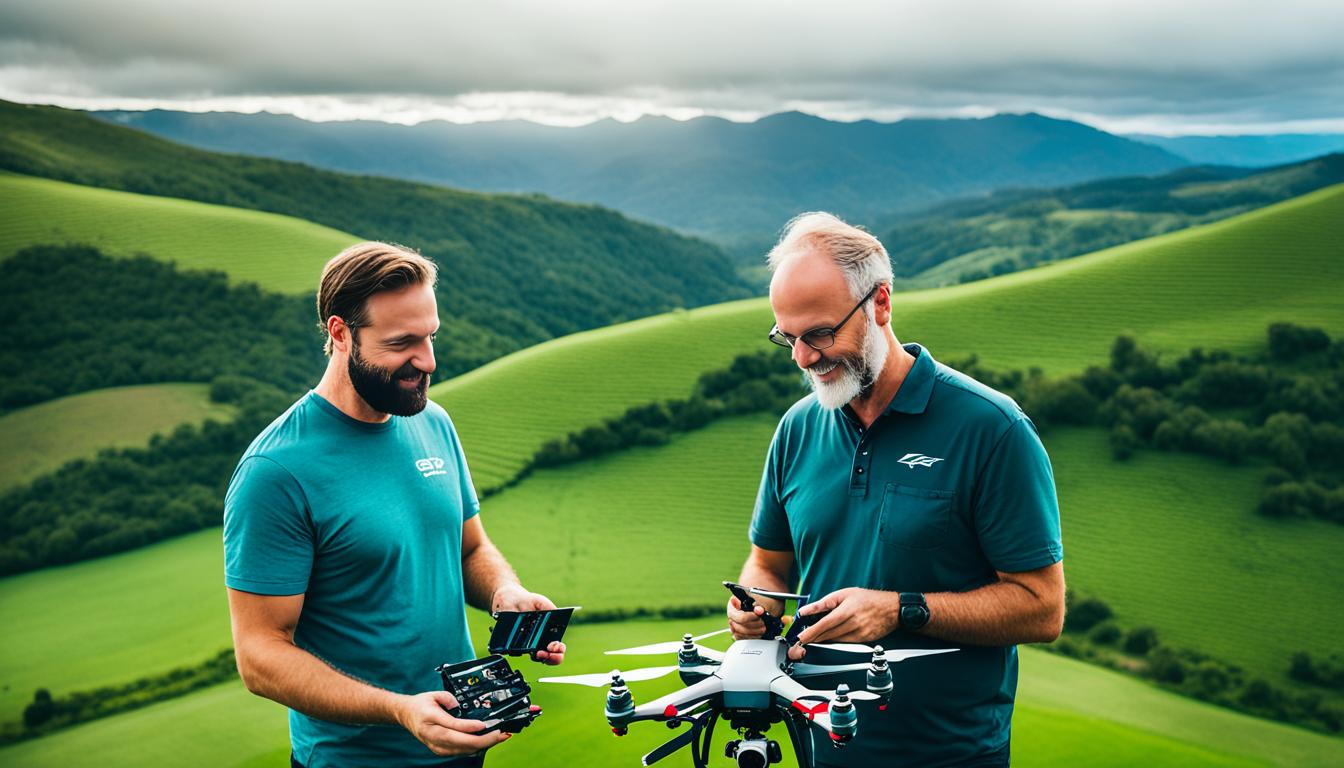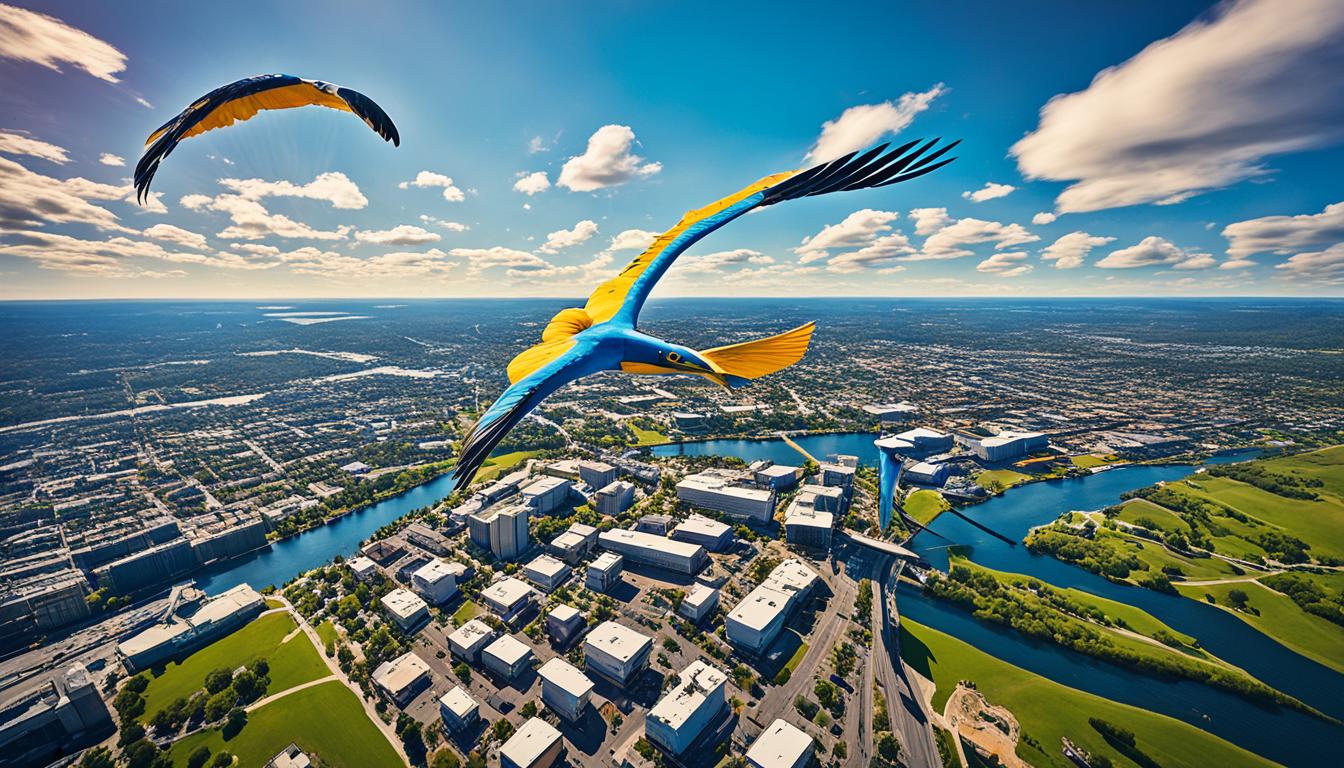In the ever-evolving world of photography and videography, aerial shots have taken the spotlight with the advent of drones. At Aerial Innovations Southeast, we recognize the significance of mastering flight techniques to capture smooth, professional-looking shots. Whether you are a beginner or an experienced pilot, understanding the capabilities and limitations of your drone model is crucial for producing stunning aerial photography and cinematic shots.
Drone photography techniques and aerial videography with drones require skill and practice. It’s not just about flying a drone; it’s about leveraging its capabilities to create captivating visuals. From controlling your drone with finesse to composing a shot that tells a story, there are numerous aspects to consider. Our aim is to provide you with the knowledge and guidance to help you master the art of drone flight for aerial photography.
Key Takeaways:
- Understanding the capabilities and limitations of your drone model is crucial for capturing stunning aerial shots.
- Mastering flight techniques such as altitude control and smooth movements is essential for eliminating jerky footage.
- Composition techniques, such as framing and leveraging colors, play a key role in creating captivating aerial photography.
- Crafting cinematic shots involves filming during the golden hours and experimenting with dynamic angles.
- Continuous learning and community engagement are essential for refining your skills as a drone pilot.
Essential Tips for Beginner Drone Pilots
For beginner drone pilots, embarking on the journey of piloting a drone can be an exciting and rewarding experience. However, it is important to study the craft and understand the principles of flight and control before taking to the skies. By gaining knowledge about your drone and prioritizing safety, you can ensure smooth and successful flights while capturing breathtaking aerial shots.
Study Drone Piloting and Know Your Drone
As a beginner, it is crucial to study drone piloting to familiarize yourself with the basics. Understanding flight principles, navigation controls, and the features of your drone model will help you gain confidence and control while flying. Take advantage of online resources, tutorials, and manuals to expand your knowledge and skill set.
“Knowing the capabilities and limitations of your drone model is essential for safe and successful flights.”
Every drone model has its own unique features and limitations. Take the time to read the user manual thoroughly, paying close attention to specifications such as maximum flight altitude, battery life, and operating range. By knowing the capabilities and limitations of your drone, you can plan your flights accordingly and avoid any unexpected issues.
Prioritize Safety in Drone Flight
Ensuring safety should be the top priority for every drone pilot. Before taking off, perform a pre-flight checklist to ensure that your drone is in optimal condition. This includes checking the battery level, propeller integrity, and any required firmware updates. Additionally, check for local regulations and restrictions that may affect your flight planning.
When choosing a flying location, opt for an open area with minimal obstacles and distractions. Avoid flying near airports, crowded public spaces, or restricted areas. Maintaining a safe distance from people, buildings, and wildlife is vital to prevent accidents and to comply with regulations.
Remember to respect the privacy of others and obtain permission if you are planning to fly over private property. By practicing responsible and ethical flying, you contribute to the overall safety and reputation of the drone community.
Perfecting Aerial Shots through Altitude and Smooth Movements
Maintaining a steady altitude is crucial for achieving remarkable aerial shots. Whether you’re capturing breathtaking landscapes or action-packed moments, nailing the right altitude can make all the difference in the final footage. To ensure smooth aerial shots, it’s important to eliminate jerky movements and employ controlled finesse in your drone piloting skills.
Altitude: The Key to Smooth Aerial Shots
To capture smooth aerial shots, finding the ideal altitude is essential. Maintaining a consistent height allows you to focus on capturing stunning visuals without worrying about fluctuations in your drone’s position. Utilize your drone’s altitude-hold feature if available, or expertly make delicate adjustments to the throttle input to achieve and maintain the desired altitude throughout your flight.

Eliminating Jerky Footage through Refined Control
Jerky footage can distract viewers from the intended beauty and impact of your aerial shots. To eliminate undesired shaking and instability, it’s crucial to employ smooth and controlled movements. Avoid sudden or drastic control inputs that can lead to unpredictable drone behavior. Instead, focus on gradual and precise adjustments to your drone’s flight path and speed.
Banking and Panning Techniques for Cinematic Fluidity
Adding dynamic and cinematic fluidity to your aerial shots can take them to the next level. Two key techniques to achieve this are banking and panning.
Banking refers to tilting the drone at an angle while maintaining altitude to create a sense of depth and dimension in your shots. It adds a dynamic perspective, allowing viewers to feel more immersed in the scene.
Panning involves smoothly rotating the drone horizontally while maintaining a fixed point of interest in the frame. This technique helps in capturing sweeping panoramic shots and following action sequences seamlessly.
Mastering altitude control for smooth aerial shots and refining your movements with banking and panning techniques will elevate your drone photography and videography skills, resulting in stunning and visually captivating content.
Crafting the Perfect Drone Shot with Composition Techniques
Creating a captivating drone shot goes beyond soaring through the skies. It involves considering elements such as the interplay of colors during different times of the day and leveraging framing techniques like the rule of thirds and leading lines. These techniques guide the viewer’s eye and create a captivating focal point in your aerial content.
When framing your shots, the rule of thirds is a fundamental technique that adds balance and visual interest. Divide your frame into a 3×3 grid and position your main subject along the intersection points. This helps create a harmonious composition by avoiding a centered and static image. Let’s take a look at an example:
| Image | Description |
|---|---|
| Example of a well-framed shot using the rule of thirds. The lighthouse is positioned along the left vertical grid line, while the horizon is placed along the lower horizontal grid line, creating a visually appealing composition. |
Another effective technique is utilizing leading lines. These are natural or man-made elements that guide the viewer’s eye towards the main subject. Leading lines can be roads, fences, rivers, or any other long, linear elements in the scene. By incorporating leading lines, you can create depth and draw attention to the focal point of your aerial photograph.
“Framing techniques like the rule of thirds and leading lines are powerful tools that can transform an ordinary drone shot into an extraordinary visual masterpiece. By studying composition principles and experimenting with different perspectives, you can craft compelling aerial content that captivates and engages your audience.”
In addition to framing techniques, the interplay of colors can greatly enhance the impact of your aerial photographs. Different times of the day offer unique lighting conditions, which result in varying color palettes. The warm tones during sunrise and sunset, known as the golden hour, can create a magical and enchanting atmosphere. On the other hand, the vibrant colors of a clear blue sky can convey a sense of tranquility and serenity.
Consider the following tips for incorporating colors in your aerial photography:
- Shoot during the golden hour for warm, soft hues that create a captivating mood.
- Experiment with shooting during different weather conditions to capture the natural variations in colors.
- Contrast the colors of the sky and the landscape to create visually striking compositions.
By understanding and implementing framing techniques and color considerations, you can elevate your drone shots from ordinary to extraordinary. The key is to experiment, practice, and develop your own unique style that captures the essence of the scene.
Unlocking Cinematic Wonder: Tips for Compelling Aerial Content
When it comes to capturing breathtaking aerial footage, there’s an art to creating cinematic drone shots that truly mesmerize. One key factor in achieving this is the magical lighting of the golden hours at sunrise or sunset. The warm, soft glow during these times of day adds a touch of enchantment to your footage, elevating it to new heights. By harnessing the golden hour magic, you can create visually stunning and captivating aerial content that stands out from the crowd.
The power of dynamic angles should not be underestimated when it comes to crafting compelling aerial content. By exploring different perspectives and viewpoints, you can add drama, depth, and intrigue to your footage. Experiment with high and low angles, bird’s eye views, and sweeping shots that showcase breathtaking landscapes or architectural wonders. Dynamic angles not only keep your audience engaged but also contribute to the overall storytelling experience.
Aerial videography is a powerful medium for storytelling in motion. With a drone, you have the ability to capture stunning footage from unique vantage points, creating a narrative that unfolds seamlessly. Think about the story you want to tell and the emotions you want to evoke. Strategic composition and intentional framing can help guide your viewers’ attention and immerse them in the story you’re portraying. Use leading lines, interesting focal points, and contrasting elements to enhance your storytelling prowess.
As you craft your cinematic aerial content, don’t overlook the impact of speed. Adjusting your drone’s speed can evoke different emotions and create a sense of movement within your shots. Play around with slow-motion footage for a dramatic effect or increase the speed for an adrenaline-inducing experience. The speed at which your drone moves through the air can greatly enhance the cinematic experience and keep your audience on the edge of their seats.
In summary, crafting compelling aerial content involves capturing cinematic drone shots during the golden hours, exploring dynamic angles for added drama, utilizing storytelling techniques to create a narrative, and adjusting the speed of your drone to enhance the overall cinematic experience. By incorporating these tips into your aerial videography repertoire, you’ll be able to unlock a world of cinematic wonder and leave your viewers captivated.
Conclusion
Mastering drone flight techniques for aerial photography allows you to capture stunning shots and elevate your visual storytelling. With practice, knowledge of your drone’s capabilities, and a creative eye for composition, you can create breathtaking aerial content.
Remember to prioritize safety throughout your drone photography journey. Always conduct pre-flight checks and fly in suitable locations with minimal obstacles. By continuously refining your skills through learning and engaging with the drone community, you can stay up-to-date with the latest techniques and ensure safe and successful flights.
Start your journey into the world of drone photography today and unlock the limitless possibilities of capturing the world from above. Experience the thrill of soaring through the skies and capturing unique perspectives that will captivate your audience and leave a lasting impression.
FAQ
What are some essential tips for beginner drone pilots?
Beginner drone pilots should study the craft and understand the principles of flight and control. It is important to know the capabilities and limitations of your drone model for safe and successful flights. Prioritizing safety through pre-flight checks and choosing suitable flying locations with minimal obstacles is crucial for smooth and visually appealing shots.
How can I maintain a steady altitude for remarkable aerial shots?
To maintain a steady altitude, you can utilize your drone’s altitude-hold feature or make delicate adjustments to the throttle input. Keeping your drone at a consistent height helps eliminate jerky footage. Additionally, employing controlled finesse in your drone movements by avoiding sudden or drastic control inputs is essential for achieving smooth and visually appealing shots.
What composition techniques can help me create captivating drone shots?
Creating captivating drone shots involves considering elements such as the interplay of colors during different times of the day and leveraging framing techniques like the rule of thirds and leading lines. These techniques guide the viewer’s eye and create a captivating focal point in your aerial content.
How can I unlock cinematic wonder in my aerial content?
To unlock cinematic wonder in your aerial content, you can film during the golden hours of sunrise or sunset to create a magical ambiance. Exploring dynamic angles adds drama and intrigue to your footage, while crafting a narrative through your shots creates an immersive storytelling experience. Additionally, adjusting your drone’s speed can evoke different emotions and enhance the cinematic experience.
How Can Mastering Drone Flight Improve My Drone Photography Skills?
Mastering drone flight is essential for improving your drone photography skills. By taking a drone photography basics tutorial, you can learn how to control your drone more effectively and capture stunning aerial shots. Understanding the technical aspects of flying a drone will greatly enhance your photography capabilities.
Source Links
- https://www.bluefalconaerial.com/master-the-art-of-drone-cinematography-essential-techniques-for-stunning-aerial-shots/
- https://aerialsoutheast.com/mastering-drone-flight-techniques-for-smooth-and-professional-looking-shots/
- https://shop.open.store/blogs/discover/mastering-drone-photography-tips-tools-for-stunning-aerial-shots




